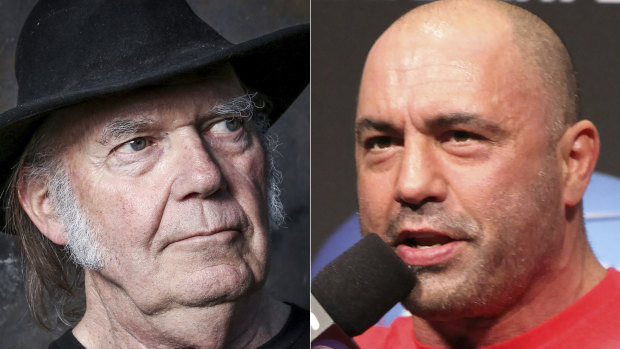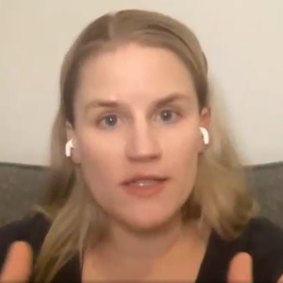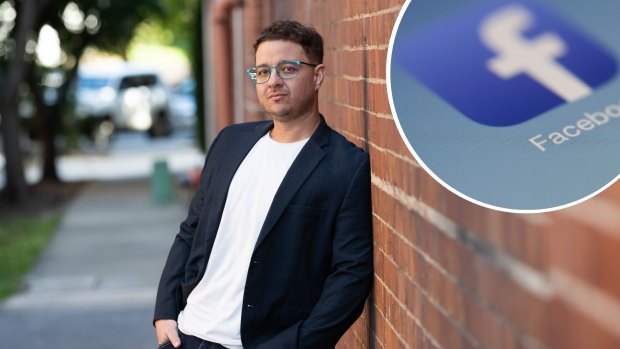- Analysis
- Technology
- Social media
This was published 2 years ago
Working through the eye of a social media storm
This week, while the world was preoccupied with a handful of high-profile artists pulling their music off Spotify in protest at what they saw as vaccine misinformation circulated by its marque podcaster, Joe Rogan, the Facebook whistleblower Frances Haugen was video calling with MPs in Australia.
She told them Facebook, which has since renamed its parent company Meta, was making decisions on what people could and couldn’t say online based on settings that determined how aggressive or cautious its AI system is in pulling down content that potentially violated its rules.

The Canadian star Neil Young, left, has pulled his music from Spotify because of segments on Joe Rogan’s podcast.Credit: AP
“Right now, we don’t have a democratic process that gets to choose those settings, we get a unitary actor, Facebook, that does it in private and secret,” Haugen said. “And I guarantee you, they would do a lot better job if they spent twice as much money on it. And they don’t do that because they know they get away with it.”
The timing and thrust of Haugen’s evidence - much of which Facebook disputes - points to two larger truths about content moderation online.
First, some cases like Rogan or Dave Chappelle, the polarising comedian who delivered a set on Netflix last year that trans activists saw as demeaning, are so big and important to the companies involved that they are handled very differently to the average offensive Twitter post. And secondly, at either end of the scale, there is a lot of money riding on getting content moderation right.
Technically and ethically, what stays up and what comes down is not an easy question. In 2018, the technology industry site the Information reported a group of Spotify employees were given an apparent transcript of a podcast that advocated for graphic violence against police and were asked whether it should be pulled down in an internal workshop.

Facebook whistleblower Frances Haugen gives evidence to a parliamentary inquiry in social media. Credit: Supplied
Almost everyone agreed. But rather than plainly menacing discussion on a podcast, the words were in fact a series of lyrics from the acclaimed hip hop group NWA, founded by rappers Dr Dre, Eazy-E and Ice Cube.
Spotify has used the last few years to race headlong into podcasts, despite their difficulties, making them a focus of its site alongside its traditional music streaming business. Hosting exclusive shows like Rogan’s, which is estimated to have about 11 million listeners and was brought to Spotify for a reported $US100 million ($A140 million), is a savvy play for the platform.
It means it can differentiate itself from rival services like Apple Music, which offers basically the same array of big label songs as Spotify. Perhaps it will even be able to use its loyal podcast listeners as a way of negotiating better deals with record labels.
Those ties, and Spotify’s promotion of Rogan’s show, mean that even though it does not control the comedian and mixed martial arts commentators’ interviews, it is closer to having editorial oversight than Facebook does for posts on its platform.
Those ties distinguish the Spotify-Rogan case from most other decisions that platforms make about what content to remove, which happen at vast scale and often through the use of AI-driven systems. But while Spotify’s closeness to Rogan will likely have made it think more carefully about whether episodes of his show that spread doubts about vaccines should stay online, the balancing act it is playing is fundamentally the same as other platforms.
“We know we have a critical role to play in supporting creator expression while balancing it with the safety of our users,” Spotify chief executive Daniel Ek said in a statement last week. “In that role, it is important to me that we don’t take on the position of being content censor while also making sure that there are rules in place and consequences for those who violate them.”
But some level of censorship is the flipside of enforcing rules about acceptable speech. Spotify’s recently unveiled content rules, for example, prohibit content that incites violence based on things like sex or ethnicity or promotes the sale of illegal goods, like drugs.
Such policies are table stakes, mirroring much of what society at large prohibits, though enforcement is another matter.
Queensland University of Technology Professor Nicolas Suzor, who researches internet regulation, says governments are not capable of directly regulating all internet content.

QUT’s Nicolas Suzor, who was not speaking in his capacity as a member of the Facebook oversight board, says governments are not capable of directly regulating all internet content.Credit: Attila Csaszar
“The scale that we’re talking about here, hundreds of millions of posts every day, means that the government machinery is just too slow to handle that,” says Suzor, who sits on Facebook’s oversight board, a kind of Supreme Court for the platform that handles appeals on content decisions, but was not speaking in that capacity.
“You can’t push this for tribunals and courts and those sorts of mechanisms. So it has to be, to some extent, devolved out to private regulation. That’s the game the platforms are in.”
Like Haugen, who advocates for Facebook to have to make its algorithms more transparent, Suzor also sees a role for more state intervention in the sector, where it is done appropriately.
In Australia, the eSafety Commissioner, a federal agency, has been given powers to order the takedown of some categories of material, such as image-based abuse and violent terrorist imagery. But the treatment of the thornier category of misinformation has been largely left up to the industry.
Digital Industry Group Incorporated, a lobby group for big technology firms such as Meta, Google, which owns YouTube, Twitter and Snap, which owns Snapchat, released its Australian Code of Practice on Disinformation and Misinformation in February last year. While its development was overseen by the Australian Communications and Media Authority, the government agency has no role in enforcing the code.
Spotify is not a signatory to the voluntary code but in the wake of the Rogan saga, it has unveiled its own policies globally. They include banning: “content that promotes dangerous false or dangerous deceptive medical information that may cause offline harm or poses a direct threat to public health”.
Rogan’s podcasts, for which he issued a statement at times both contrite and defiant, remain online, indicating Spotify does not see them as rising to that level. It will, however, add a disclaimer to podcast episodes that deal with COVID-19, directing users to trusted sources of information on the pandemic and vaccines. Rogan too has said he will have more mainstream medical guests on to counter some of the fringe voices he interviews.
Other platforms are taking a similar response to nudge users in the right direction or allow more choice. Speaking at the same parliamentary Online Safety Committee that Haugen addressed, Meta’s Australian head of public policy, Josh Machin told the committee that the company wanted to give its users more control over how their news feeds appear.
“It shouldn’t be a decision that we are making; we want to be transparent about steps we are taking that feed into how our ranking algorithms work, but we want to give individual users greater tools and controls so they can customise their news feed to look more like what they would like to see,” Machin said. “If they want a news feed that doesn’t include any politics, for example, because they only want to engage with family and friends, they should have those tools available.”
For Facebook, the appeal of such a system that lets users pick their content is obvious: it retains the content that people want to engage with, retaining users’ attention and the advertising dollars that go with it.
There are other nudge methods too, which platforms are deploying alongside their existing methods to counter outright hate speech, misinformation or illegal content. The major platforms have repeatedly emphasised how they are improving the calibre of their systems and taking down volumes of malicious posts. Facebook has published lists of the type of content it shares to fewer people, such as fact-checked misinformation, sensationalist health content, and posts from users with multiple accounts.
For example, in response to Holocaust denialism on its platform, TikTok announced last week it would include a banner on related search terms pointing viewers to reliable information. Figures from the United Nations showed that before the banners were introduced, 17 per cent of content about the Holocaust on TikTok either denied or distorted the truth of the cataclysm.
Pinterest, the online image board service; Instagram, the photo and video sharing app; YouTube, the video and streaming service; and Twitter, the short form public commentary platform, all have features that encourage users to reflect before posting potentially offensive material.

The major platforms have emphasised how they are improving the calibre of their systems and taking down volumes of malicious posts.Credit: Supplied
There is some evidence that such nudge approaches can be effective. A study from Twitter and Yale University’s law school published this week found that 31 per cent of people shown pop up messages asking them to reconsider a potentially offensive tweet either revised it or chose not to post it at all.
But the overall impact was modest: these users posted 6 per cent fewer offensive tweets compared to a control group.